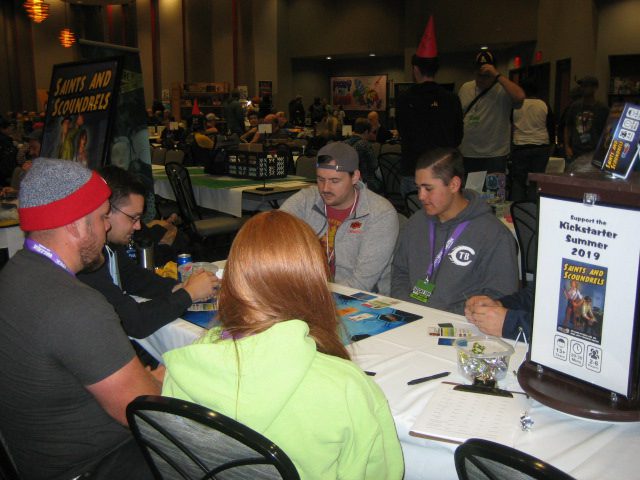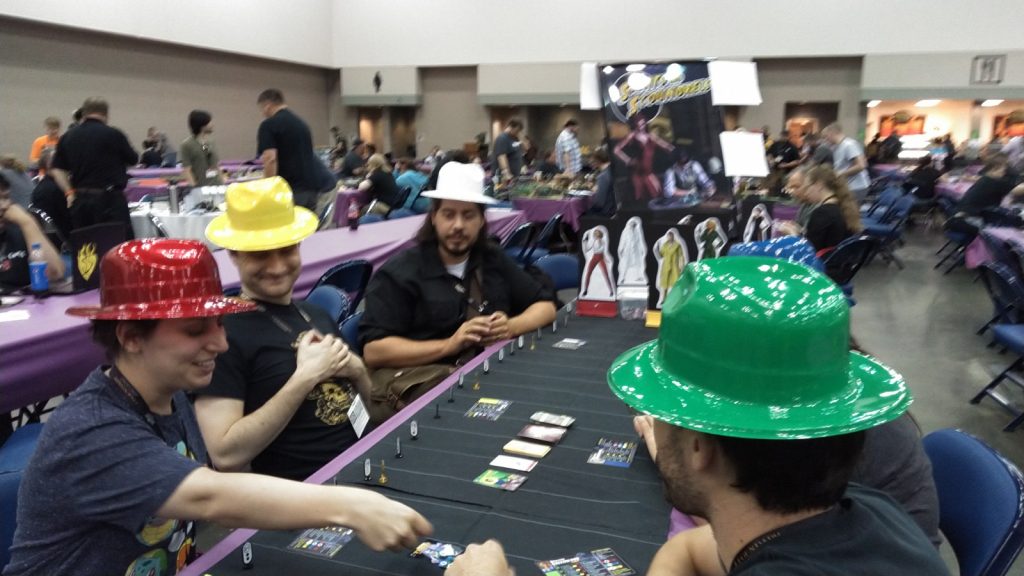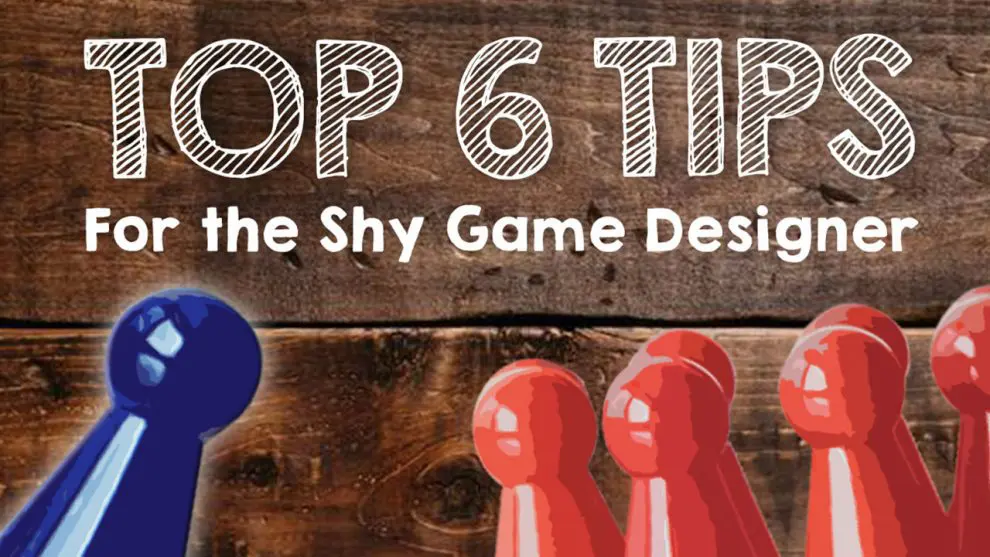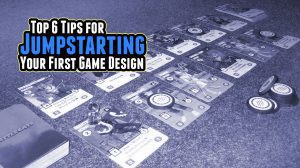Whether you’re playtesting a design in progress or demoing a finished title at a con, asking complete strangers to play your game is just an awkward experience. The game that you spent years perfecting may be truly awesome, but condensing your thousands of hours of hard work into a 30 second pitch sounds like a near impossible task, especially if you’re on the shy side to begin with. But once you start engaging the public, you’ll likely find sharing your awesome work, and watching others enjoy your creation, is one of the most rewarding aspects of game design. Below I’ve put together a list of 6 actionable tips to help you get started showing your game in public.
You Don’t Need to be Pushy, Just Knowledgeable
While it certainly doesn’t hurt to be an extrovert, it’s definitely not required when showing off your game. I’ve met several great designers who are very shy. However, demonstrating your game well means you will need to be very knowledgeable and self-assured. Playtesting a game can be a big time commitment; people will want to know if it is something they will enjoy. They may even be trying to decide between playtesting your game or another.
People are going to ask you about your game, So you should know the intended audience (is it for casual or hard core gamers), you should know which popular games have similar mechanics and themes, and most importantly, you should know what makes your game fun and unique. These may sound like simple questions but they are actually very difficult to answer objectively, especially for a game designer who has put their heart and soul into a game. The best way to answer these questions is to talk to your playtesters or other game designers. They may provide insight into aspects of your game that you’re just too close to see.

If people agree to play your game, that’s great but your job isn’t over. Not only are you the game designer but you are also the Game Master (GM). Most players will likely feel overwhelmed, at least initially, with rules and concepts. As GM you should keep your players focused on theme rather than just mechanics. As the game progresses, paint a picture of what their decisions mean in terms of the game world. Don’t just congratulate a player for a good card play, praise the player for defeating the barbarian hordes and bringing honor to his/her family!
Set-up an Inviting Table
You will want to show people how eager you are to show your game. You can’t expect people to get excited about it if you’re not. The best way to highlight your enthusiasm is to have an eye-catching table. One of the easiest ways you can decorate your table is to place framed pictures on your table which reflect the theme of your game. This is also one of the most budget friendly ways to set-up your table, since you can buy a couple of 8.5 X 11 inch frames and color print some art from your game.

If possible, be sure to check the event web site or contact the con organizers about the size of your demo table. Sometimes your table options won’t make any sense. If your table is too small or large, it’s better to know this before the demo rather than after you arrive, so that you can make plans to adjust accordingly.
You also want to ask the organizer if they will supply table covers and what kind they will be. Most cons will provide a white cloth table cover, and while these work fine I prefer bringing my own. I like going to my local fabric store and buying a few yards of colored felt. Make sure to pick a color that helps highlight your game. Darker colors highlight colorful components. You also want to check with the con organizers that it’s OK to bring your own table top cover. For a more polished (and more expensive) table cover, order a customized neoprene mat. I have one with my “GCRS Games” logo on it that I ordered from Inked Gaming. If you’re worried about cold drinks on your newly bought felt table cover or neoprene mat, bring some coasters with you.
You can make a great impression by having a banner next to your table, but make sure the the con organizers will allow it. They tend to take a lot of space so make sure you’re not blocking the aisle or blocking another designer’s demo table. You’ll also need some kind of stand to hang your banner on. I’ve seen banners and stands range in price from $150 to $500 or more. Having a banner is the standard for game designers but I prefer a poster, frame, and tripod. I got my 2 x 3 foot frame and tripod on sale at my local craft store on sale for about $50, and I got a poster printed up at FedEx Office for another $50. I like the tripod and poster because you can easily reuse the hardware for your next game.
Put Together an Awesome Pitch
Pitching your game to passersby may seem very intimidating but it’s actually one of the easiest parts of demoing your game. If someone looks like they’re looking for a game to play, just say a simple, “Hi, how are you?” If they ignore you or act like they have other things to do then I let them go. Otherwise, just ask “Can I tell you about [your game name]?” If they say yes then I recommend giving them two pitches. The first is a 30 second “elevator” pitch which includes the following information:
- Number of players
- Typical game time
- Age range
- Theme
- Primary game mechanics
Practice this pitch so that you can get through it in 30 seconds or less but still sound clear. Then ask if they have time to hear your “2 minute overview”. If they say yes to this then go much deeper into explaining the game, being sure to include information like:
- Component overview (functions and how they relate to theme)
- What a player does on a typical turn
- Win conditions
I end my pitch by asking if they would like to try my game. I’d say about 75% of the people who hear my Overview pitch agree to play my game. Those that don’t want to play, usually don’t like the theme or mechanic. Sometimes they’re just looking around at all the available games and are not quite ready to commit. If someone seems genuinely interested but doesn’t want to sit down, I give them my business game card which is basically a mini sell sheet (see below).
If someone says yes, introduce yourself, ask them their name(s), offer them seats, and go into rules explanation. If your game takes longer than an hour to play, some people may not want to play for that long. So be aware that longer games may have limited audiences. You may want to create a shorter demo version of your game, perhaps playing through just a few rounds instead of the entire game. It’s ideal to demo your game in 30 minutes or less, the quicker the demo, the more people you can demo it to.
Take Advantage of your Location or Adapt to it
The location of your demo table is key to getting players. If you can get a spot right next to a high traffic area, you’re golden. However, if you’re tucked away far from the crowd, it may take a little extra effort to find players. At this year’s Gen Con I was placed behind a giant Warhammer 40K space hulk. It was an awesome sight but not exactly ideal for getting attention for my game.
What I ended up doing was grabbing my 3’ x 2’ framed poster, standing next to the high traffic area, and loudly announcing that I was looking for players. However some cons no longer allow you loudly vocalize you’re need for players and will require you wait until you are approached first before you can say anything. This is where having a big sign or prop is a big help. At Gen Con my poster came in very handy. It is easy to take off the tripod and show the crowd. Other designers held up their box to attract players. This is a great idea if you have a decent sized box, but I wouldn’t attempt this with a small box. When barking, it’s a good idea to use a large finished piece of art to attract players.
Gathering players by barking may sound tedious but it’s surprisingly effective, it was my primary method of attracting players at Gen Con. Most other designers I talked to had a similar experience. Many attend cons looking for a unique experience or a “hidden gem” board game before it hits Kickstarter.
Be Mindful of the Changing Crowd
One of the most interesting and important lessons about demoing at a con or game store is how the crowd differs depending on the day of the event. I’ve found slightly changing my pitch to fit the crowd was a big help to getting more players.
Weekdays often attract more experienced players, people who really enjoy board games and will set aside time to play them. For this crowd, I’ll emphasize my pitch on primary game mechanics and uniqueness. If your game has an intriguing game mechanic or an uncommon theme this crowd will eat that up.
Saturdays are often the busiest days of any con. Crowds are usually more casual game players. On Saturdays, I focus my pitch on theme, gameplay length, and player count. Some players, especially more casual gamers, will love a game instantly based on a specific theme like dragons, fairies, Cthulhu, etc. Casual gamers generally prefer shorter games, especially at a busy con. If your game is less than an hour, particularly if it’s under 40 minutes, be sure to emphasize that. Saturdays also attract larger groups of friends who want to play games together. If your game plays more than 4 people be sure to emphasize that as well.
The Sunday crowds are usually made up of families. When pitching to a family, I make sure to be honest about my game’s target audience. While I usually don’t design family games, my games are also not “for adults only”. I usually tell people the age of the youngest person who has played and enjoyed my game. I also assure families in advance that my feelings won’t be hurt if they want to stop after a round or two.
Go the Extra Mile
If you want to stand out from the other demo-ers just a little, there are a few more things you can do.
Candy
Many demo-ers like to put out a bowl of candy at their demo table. But be careful with this. You want to get the RIGHT kind of candy. I usually go with the name-brand mini-chocolate bars. Very few people will turn down free chocolate. I’ll often start my pitch by offering the chocolate. While they are unwrapping and eating the chocolate, I’ll give them the rest of the pitch. Sometimes I wonder if people play my game just to have more chocolate. Stay away from buying off-brand hard candies. They just don’t get people very excited.
Hand Sanitizer
Con crud is real! I like to buy a bottle of hand sanitizer before every big con. I prominently display it on my table and invite my players to use it. I also let the game designers demoing around me know about my hand sanitizer. It has a surprising relaxing effect on players. I honestly think having hand sanitizer helps my players enjoy the demo a little more.
Costume
I know this article is aimed at the “introverted” game designer but consider demoing in costume. I know a few shy game designers who feel much less shy once they pretend to be someone else. It’s a great way to advertise your game, even when you’re away from your table. Of course the costume should go along with the theme of your game.
Eye-catching Prop
An interesting prop is a great conversation starter. Some people will stop just to look at the prop, providing a great opportunity for your “elevator pitch”. I’ve seen designers with cool figurines or models which relate to their game’s theme. But you don’t necessarily need something that relates to your theme. I made something I call my “Game Kiosk”. It’s a three-sided information booth on a lazy susan. People like to stop and spin it. When they do so, I take the opportunity to pitch my game to them.
Giant-sized Game
Over the past couple of years, creating a giant-sized version of your game has become more and more common for demoing at a con. Giant sized games get a lot of attention; people will often stop at a giant-sized game just out of curiosity. I think most con goers are looking for unique con experiences – things they can only play at the event. I created a giant-sized version of Saints and Scoundrels for Gen Con and it was a big hit. I had a few people who just wanted to play before they even knew what the game was about.
But before you start creating a giant-sized version of your game, you may want to consider a few things. First, some games translate to a larger size better than others. By mindful how cumbersome it would be to hold or move large components, especially for longer games. Second, big games will require more space. Be sure whatever you have will fit in the space you are given. Lastly, you might want to check with the con organizers, especially with smaller cons where space may be at a premium.

My Final Best Advice
Whatever you decide to do to demo your game at the con try to match the scale and spirit of the con. For a local con focused on playtesting and networking, you probably don’t want or need 5 giant banners. On the other hand, for a crazy popular national-level con like Gen Con, I say “Go big or go home!”











I relate to this, and these are great tips!